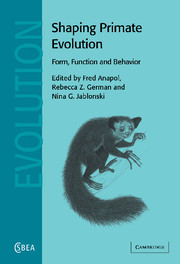Book contents
- Frontmatter
- Contents
- List of contributors
- Preface: shaping primate evolution
- 1 Charles Oxnard: an appreciation
- Part I Craniofacial form and variation
- 2 The ontogeny of sexual dimorphism: the implications of longitudinal vs. cross-sectional data for studying heterochrony in mammals
- 3 Advances in the analysis of form and pattern: facial growth in African colobines
- 4 Cranial variation among the Asian colobines
- 5 Craniometric variation in early Homo compared to modern gorillas: a population-thinking approach
- Part II Organ structure, function, and behavior
- Part III In vivo organismal verification of functional models
- Part IV Theoretical models in evolutionary morphology
- Part V Primate diversity and evolution
- Index
- References
2 - The ontogeny of sexual dimorphism: the implications of longitudinal vs. cross-sectional data for studying heterochrony in mammals
Published online by Cambridge University Press: 10 August 2009
- Frontmatter
- Contents
- List of contributors
- Preface: shaping primate evolution
- 1 Charles Oxnard: an appreciation
- Part I Craniofacial form and variation
- 2 The ontogeny of sexual dimorphism: the implications of longitudinal vs. cross-sectional data for studying heterochrony in mammals
- 3 Advances in the analysis of form and pattern: facial growth in African colobines
- 4 Cranial variation among the Asian colobines
- 5 Craniometric variation in early Homo compared to modern gorillas: a population-thinking approach
- Part II Organ structure, function, and behavior
- Part III In vivo organismal verification of functional models
- Part IV Theoretical models in evolutionary morphology
- Part V Primate diversity and evolution
- Index
- References
Summary
Introduction
As the name suggests, studies of sexual dimorphism began with a focus on morphological differences between the sexes (Darwin 1871). Current use of the term “dimorphism” and current studies of sexual dimorphism have expanded to include ecological, behavioral, and physiological differences between the sexes (Harvey and Clutton-Brock, 1985). Charles Oxnard (1987) brought his unique quantitative perspective to the investigation of sexual dimorphism, showing that studies, particularly quantitative studies, of differences between the sexes in morphology are meaningful and not outdated. His work has provided inspiration for this chapter, which examines the role that data and analysis play in understanding evolution. As Oxnard identified multiple dimorphisms among taxa along morphological axes, this study examines heterochronic variation among taxa to show that different ontogenetic trajectories produced analogous multiple dimorphisms. Crucial to Oxnard's work, and to the results presented here, are matches among question, data, and method.
Studies of sexual dimorphism and growth
Most research addressing questions of growth and sexual dimorphism examines the ontogeny of that dimorphism, focusing on how growth produces adult differences (see German and Stewart, 2002 for review). A slight shift in focus to the sexual dimorphism of ontogeny, or the way the sexes grow, will generate alternative questions, centering on the differences in growth itself (e.g., Watts and Gavan, 1982; Glassman et al., 1984; Coelho, 1985; Watts, 1986).
Growth in mammals has a number of distinguishing characteristics that make comparisons of growth between two groups difficult, whether they are sexes or species. Mammalian growth is nonlinear.
- Type
- Chapter
- Information
- Shaping Primate EvolutionForm, Function, and Behavior, pp. 11 - 23Publisher: Cambridge University PressPrint publication year: 2004
References
- 8
- Cited by



